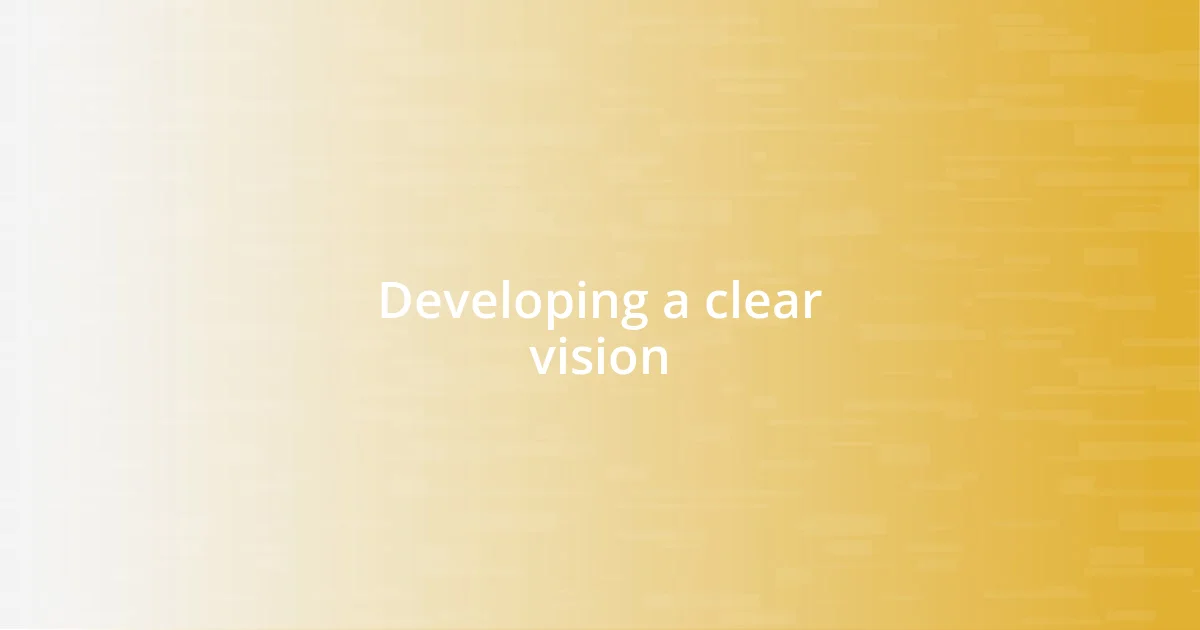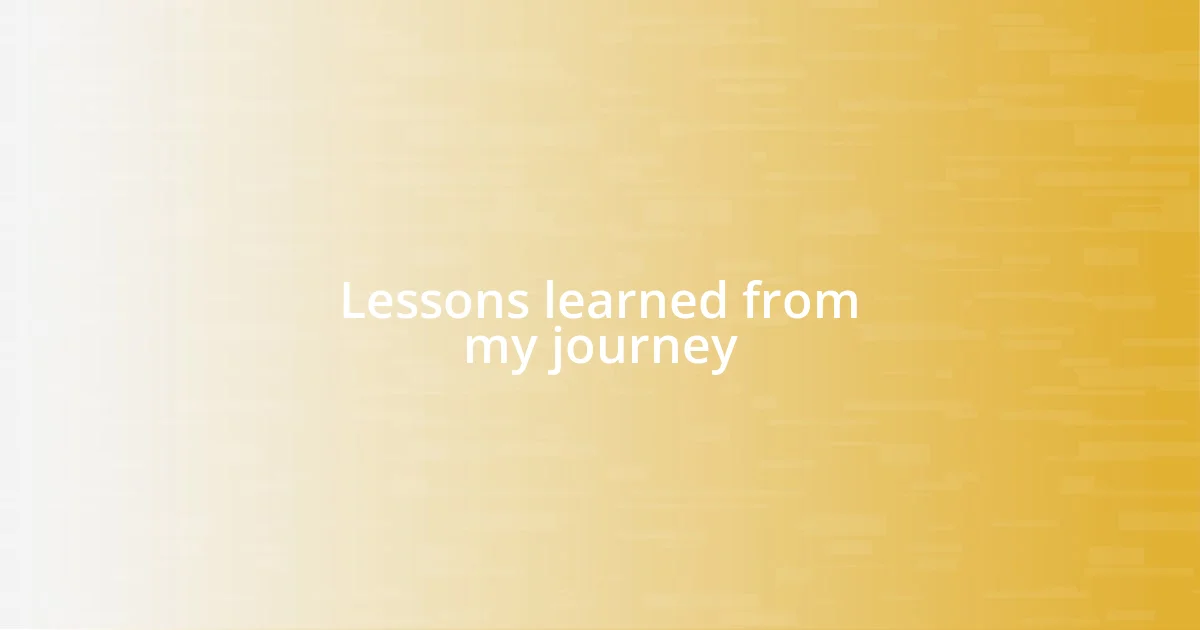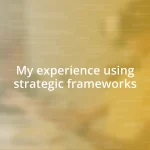Key takeaways:
- Clear vision and emotional intelligence are crucial for successful strategic transformations, helping to align efforts and address team concerns.
- Engaging and communicating with diverse stakeholders, including frontline employees, enhances decision-making and fosters collaboration.
- Celebrating milestones and embracing adaptability, vulnerability, and feedback are essential for measuring success and fostering a supportive team culture.

Understanding strategic transformations
Strategic transformations are more than just shifts in direction; they involve a deep rethinking of core values and operations. I remember when I first faced a significant transformation at my previous company. The anxiety was palpable; we were questioning everything, from our mission to our daily practices. Have you ever felt that kind of uncertainty? It’s a pivotal moment that can either make or break an organization.
At the heart of any strategic transformation lies the need for a clear vision. Without a strong understanding of where you want to go, it’s easy to lose your way. I once facilitated a workshop where a team was stuck in outdated practices, and it was fascinating to see their reactions when we drafted a compelling vision together. That “aha” moment made all the difference in aligning their efforts.
Moreover, leading a transformation requires emotional intelligence. I learned early on that connecting with people on a human level is crucial. Once, while navigating through a major change, I paused to acknowledge my team’s fears and hesitations. By showing empathy and understanding, I could turn their hesitance into a collective drive towards our new goals. Isn’t it amazing how addressing emotions can enhance commitment?

Identifying key stakeholders for success
Identifying key stakeholders is essential in any strategic transformation journey. I recall a particular instance where I underestimated the influence of a junior team member. During a pivotal strategy meeting, she had insights that interconnected different departments, and her contribution not only shifted our perspectives but also broke down silos. It’s a powerful reminder that stakeholders can come from unexpected places. Who might you be overlooking in your own initiatives?
Understanding the diverse roles stakeholders play can dramatically impact the success of a transformation. Early in my career, I encountered a shift where engaging with frontline employees provided crucial insights that senior management had missed. I often found that the more I listened to these key stakeholders, the more informed our decisions became. Have you ever tapped into the experiences of those who work closest to the processes? Their voices can be incredibly enlightening.
Finally, maintaining open lines of communication with all stakeholders is vital. I learned this the hard way in one project where I didn’t update stakeholders regularly. Their anxiousness and misinformation led to unnecessary friction. In contrast, when I ensured transparency and sought feedback throughout the process, it transformed potential conflict into collaboration. It just goes to show how crucial it is to keep everyone in the loop.
| Stakeholder Type | Example |
|---|---|
| Executive Leadership | Sets the overarching vision and strategy |
| Team Members | Provides critical on-the-ground insights |
| Clients/Customers | Offers feedback that shapes product/service adjustments |
| Cross-Departmental Peers | Facilitates collaboration across different areas |

Developing a clear vision
When developing a clear vision, I believe clarity is paramount. I’ve experienced firsthand how a muddled vision can lead entire teams down the wrong path. During one transformation, our initial discussions felt scattered, with everyone pulling in different directions. It wasn’t until I encouraged the team to collaborate on a vivid, shared vision that we regained our momentum. The collective energy was palpable, and it amazed me how a unified goal can ignite passion and commitment across diverse individuals.
Creating a clear vision involves distilling complex ideas into simple messages. Here are key steps I found helpful:
- Engage All Levels: Include voices from every level of the organization to ensure diverse perspectives shape the vision.
- Simplify the Message: Craft a vision statement that’s concise and memorable, like a catchy slogan that encapsulates the essence of the direction.
- Visualize the Future: Encourage team members to envision what success looks like and share their mental images to foster a sense of ownership.
- Iterate Together: Don’t hesitate to revisit and refine the vision based on ongoing feedback; it shouldn’t be set in stone.
- Celebrate Milestones: Recognizing progress along the way can help keep the vision alive and relevant to the team’s daily efforts.
During another project, I vividly recall a moment where a colleague shared their vision in a painting. It struck me how powerful an artistic interpretation could be; it wasn’t just words on a page but an emotional representation of what we were striving for. That experience reaffirmed my belief that a clear vision is not just a guiding star but a collective heartbeat that drives an organization forward.

Implementing effective communication strategies
Effective communication strategies are the backbone of any transformation initiative. I learned this during a challenging project when I realized that my team craved clarity and reassurance. After numerous updates fell flat, I decided to implement weekly stand-up meetings. These informal gatherings not only provided a platform for real-time updates but also cultivated an environment where team members felt heard and valued. Have you considered how regular check-ins might enhance your team’s cohesion?
Using storytelling can also be a game-changer in communication. I once shared a personal narrative about overcoming a significant challenge while leading a previous transformation. This approach resonated deeply with my colleagues, sparking conversations and encouraging them to share their own stories. I believe tapping into narratives allows people to connect on a human level, breaking down barriers and fostering collaboration. How powerful can a simple story be in driving your message home?
Moreover, feedback is a critical element that often gets overshadowed. I vividly remember a feedback session after a major implementation phase where we gathered insights from everyone involved. The responses ranged from technical suggestions to emotional reactions, and they provided invaluable lessons. By encouraging honest feedback and demonstrating that it’s truly valued, I witnessed a notable shift in engagement and trust. Have you thought about how to create a culture that embraces feedback? The results can be transformative.

Measuring transformation success
Achieving transformation success requires a solid framework for measuring progress. In my experiences, I found that setting measurable goals right from the outset is crucial. For instance, during one transformation, we established key performance indicators (KPIs) to track our progress, such as employee engagement scores and customer satisfaction metrics. This not only provided us with tangible data to analyze but also kept the team focused on achieving specific milestones. Have you ever considered how metrics can illuminate the path to success?
But numbers alone don’t tell the whole story. I remember wrapping up a transformation initiative and conducting a qualitative survey alongside the quantitative metrics. The rich feedback revealed not only the success in reaching targets but also the emotional journeys of team members. One story stood out—an employee shared how the transformation empowered them to take ownership of their role, ultimately leading to innovative solutions. These narratives underscored the human elements behind the metrics, reminding me that measuring success is both an art and a science.
Celebrating wins, even the small ones, is another effective strategy I’ve employed. I fondly recall a quarterly meeting where we reflected on our progress. Each team member shared their proudest moment, leading to a contagious energy that reinforced our purpose. It’s essential to recognize these successes publicly; doing so fosters motivation and a sense of belonging. Do you regularly celebrate your team’s achievements? I believe it can truly catalyze growth and transformation.

Lessons learned from my journey
Throughout my journey, I’ve learned the importance of adaptability. I remember a time when we launched a new initiative that flopped spectacularly at first. Initially, I was disheartened, but I soon recognized the need to pivot based on feedback. I quickly organized brainstorming sessions where the team contributed new ideas, leading us to an unexpected yet successful approach. How often do we cling to a single plan, only to miss out on better opportunities? Sometimes, flexibility leads us where we need to go.
Another key lesson was the necessity of building strong relationships, both within and outside the team. I recall a situation where a colleague from a different department offered to help streamline one of our processes. It was a casual lunch chat that blossomed into a powerful partnership, ultimately accelerating our transformation response. This experience taught me that fostering connections can amplify efforts and create a network of support. Have you taken the time to connect with others outside your immediate team? The results can surprise you.
Finally, embracing vulnerability has been transformative for me as a leader. I distinctly remember a project where I openly admitted my struggles during a presentation. Instead of alienating my team, it brought us closer together. They responded with empathy and shared their own challenges, creating a more authentic dialogue. This openness fostered trust and camaraderie, allowing us to work more effectively as a unit. Isn’t it fascinating how vulnerability can serve as a bridge rather than a barrier? It’s a lesson I’ll carry forward in every endeavor.















